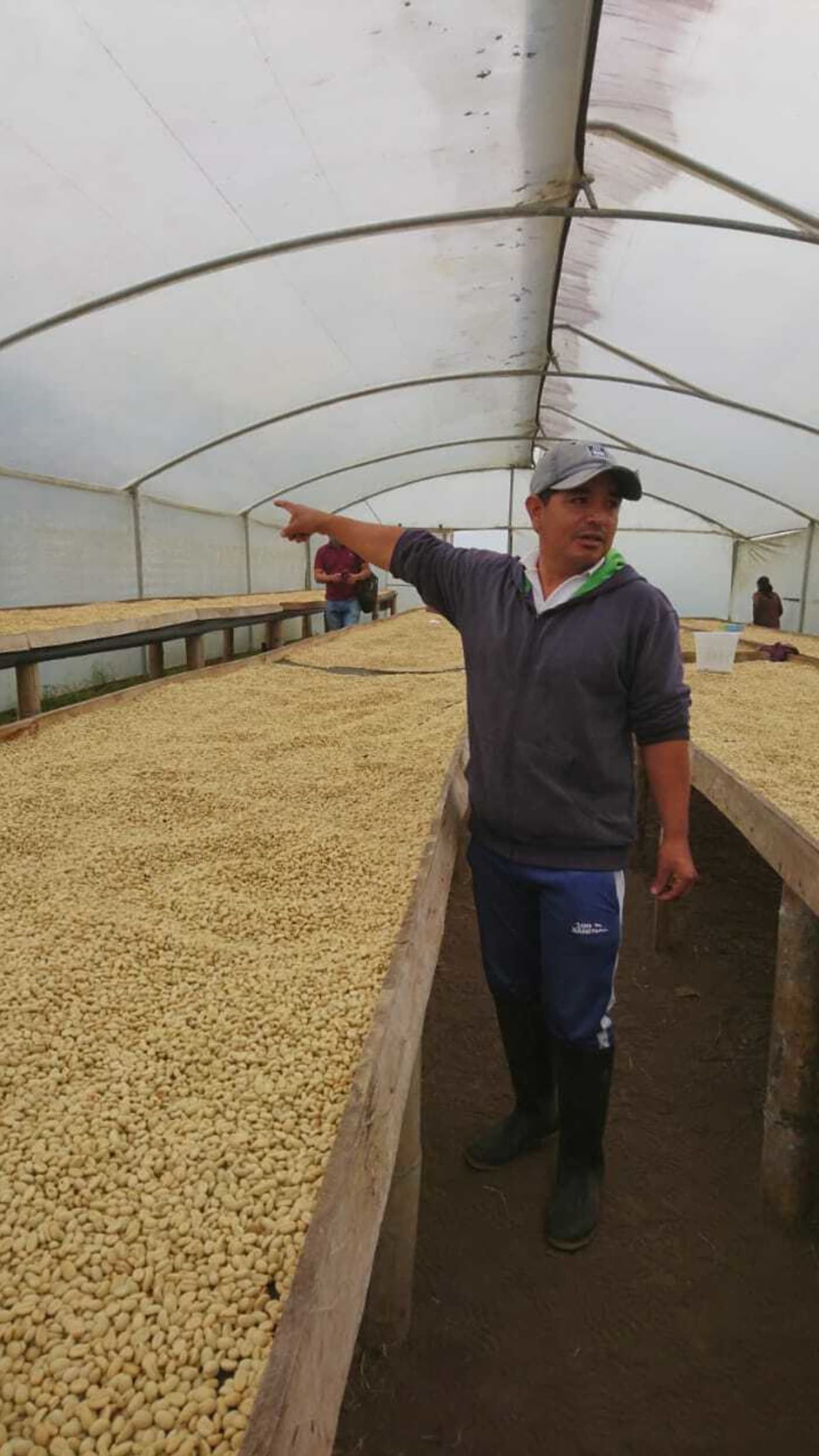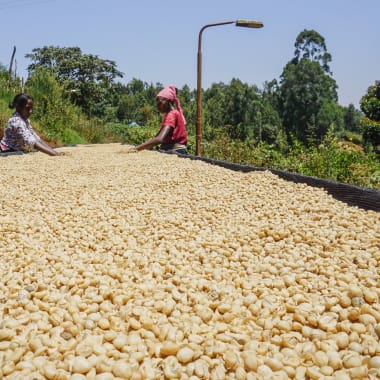-
Producer
-
Wilter Guillermo Lomas Lopez
-
Country
- Ecuador
-
Region
-
Parroquia
-
Altitude
-
1370m above sea level
-
Variety
-
Process
-
Body
-
-
Acidity
-
-
Tasting notes
-
Shortbread, apple skin, fig
-
Roast style
Ecuador
Finca La Colina
TypicaThis Typica from Wilter Guillermo is sweet and silky with lots of candy-like flavours. We taste short bread, apple skin, fig.
Wilter Guillermo, from Finca La Colina, repeats as a VS feature with this lot of washed Typica.
VERY SPECIAL
You may remember La Colina‘s previous feature—a lovely washed Sidra shared in March 2023. Well, this lot has grown in the same area, been picked by the same team and processed using the same methods. The different variable here is the varietal: Typica.
Aside from the varietal uniqueness, the lot’s high price, and the outstanding cup presence, this delivery will test our memory skills. Can you remember how the Sidra made you feel? How does this compare?

ECUADOR: IT’S COMPLICATED
As we mention in the previous La Colina feature, the price of Ecuadorian specialty coffee is generally very high due to the massive influence of the commercial instant industry. Catch up or re-read the whole story in our previous coffee from Finca La Colina.
WILTER GUILLERMO’S GIG
Like everyone here, Guillermo’s days start with a cup of coffee; he loves drinking it. Unlike everyone here, Guillermo decided to transform this passion into his profession, and even though he had no experience, he started his own coffee farm—Finca La Colina.
In 2014, he planted the first coffee trees. Even though he didn’t know much, the first harvest went relatively well; he made mistakes, and he learnt from them, but he also had many wins. It was all personal growth and self-learning, a dream come true.
In 2016, he produced a decent output: 540 kilograms of high-quality dry parchment that entered the specialty coffee market and, later that year, achieved 5th place in the Taza Dorada competition. Not bad for a beginner.

TYPICA VARIETAL
Typica is rare to see these days. It’s not because it’s a new variety—its origins can be traced back to sometime in the 15th or 16th century when it was taken to Yemen, then India, Java, Netherlands, Paris… and finally, Central America.
Until the 1940s, most coffee plantations in South and Central America were planted with Typica, but due to its low yield and high susceptibility to major coffee diseases, it has gradually been replaced with other varieties. Today, it’s still mainly planted in the Dominican Republic, Jamaica (where it is called Jamaica Blue Mountain)and Peru because it still offers a good or high-quality cup.
Learn more about the long travels of Typica at the World Coffee Research page, from which we’ve sourced this information.
THIS LOT’S PROCESS
The cherries have grown at a relatively low altitude (~1370 masl) under partial shade provided by Guamo and Plantain trees. After being picked completely ripe, they’ve been fully washed and fermented for 14 hours, then dried on raised beds in a covered patio.

All the images and information about this coffee and its producers have been kindly shared by the importer, Caravela, and edited by us, Sample Coffee (unless linked to or credited otherwise).
Resting your beans inside the sealed bag helps develop peak flavours and acidity.
Learn how long and why you should wait on our brewing window recommendations guide.
Try our step-by-step recipes and videos.
Our recipes are easy to follow and designed to bring the best out of our coffee. Find your favourite method on our brew guides collection or test a new one—and if you have any questions, ask us anytime at [email protected].
Learn everything about this coffee:
Ethical, traceable sourcing
This page has all the sourcing information (variety, process, region, story, importer, and more) that our importers share with us, and give us permission to use.
The transparency helps us talk confidently about the quality and background of our product, and it helps you know exactly what you’re buying.
Learn more:
Coffee page transparency legend
Our coffee philosophy
Our business approach
Fresh harvest coffee
We only source and roast coffee from each country’s latest harvest season (so the green coffee is never older than 1 year from the time of picking, processing and packing). This ensures the sensory qualities are always at their peak and unaffected by excessive ageing.
Roasted for espresso and filter (best enjoyed black)
Roast style: omni. Omni roasts are designed to brew and taste great both as espresso and filter. Our omni single origins generally sit on Agtron values in the ~70-60 value range. So, technically, they are somewhere in the lighter side of the medium spectrum.
Designed for espresso and filter brewing. Best enjoyed black.
Learn more:
Our Loring Kestrel S35 roaster
Our roasting style and approach
Best brewed within days 15-49 post-roast
The ‘fresh is best’ saying doesn’t apply to coffee (contrary to popular belief). Waiting before opening and brewing your bag of whole coffee beans helps develop peak flavour and acidity.
But heads up: if you buy pre-ground coffee, brew it as soon as possible.
Learn more:
Our recommended brewing window
Try our custom brewing recipes
Our recipes and ratios are tailored to our coffee sourcing and roasting styles, bringing the best flavour and feel out of each coffee.
For pour over, immersion, and other filter brewing styles, check our brew guides.
For our espresso single origins, we recommend a coffee:yield ratio of 1:3:
- Dose: 20g ground coffee
- Yield: 60g espresso
- Total brew time: ~24-28 seconds
This is just a starting point! We encourage you to experiment, taste, and adjust to find the recipe that you enjoy the most.
Learn more:
Our espresso brew guide (single origin)
Brewing ratio calculator
Packaging and sustainability
- Bags: ABA-certified home compostable (AS 5810-2010)
- Labels: recyclable
- Valves (only on +250g bags): general waste
- Box and tape (online orders): recyclable
Learn more:
Our packaging
Variety
Typica variety
Considered to be one of the ‘genus’ varietals from which all other varietals have mutated from
The location
Coffee from Ecuador
For a long time most of Ecuador’s coffee production was for commodity grade export or the production of soluble coffees (freeze dried coffee). Only in the last few years has the potential of the country’s coffee production been really explored. We’re very excited about the potential Ecuador and have some truly exceptional coffees
Farm processes
Washed process
Machines are used to remove the flesh from the coffee cherry before being fermented in water, washed again, and finally sun dried. This process tends to result in more distinct, cleaner flavours.

Subscribe to a world of coffee
Discover a new single origin coffee from Sample every 1-5 weeks with no delivery fees.
No up-front purchase, and you can pause, cancel, or change plans at any time.
Available to order online this week:

Colombia Carlos Imbachi Pink Bourbon
Flavours of pear, jasmine, sugarcane
Body Acidity
Washed Pink Bourbon
February 2025 harvest
Roasted omni for filter and espresso
Colombia Carlos Imbachi Pink Bourbon online
Nicaragua Guillermo Montenegro
Flavours of plum, nectarine, shortbread
Body Acidity
Washed Caturra
March 2025 harvest
Roasted omni for filter and espresso
Nicaragua Guillermo Montenegro online
Ethiopia Bekele Gemeda
Flavours of mandarin, white peach, mango
Body Acidity
Washed Ethiopian Heirloom
November 2024 harvest
Roasted omni for filter and espresso
Ethiopia Bekele Gemeda online
Kenya Karindundu Aa
Flavours of orange marmalade, grapefruit, Yunnan red tea
Body Acidity
Washed Batian, SL28, SL34, Ruiru 11
Roasted omni for filter and espresso
Kenya Karindundu Aa online